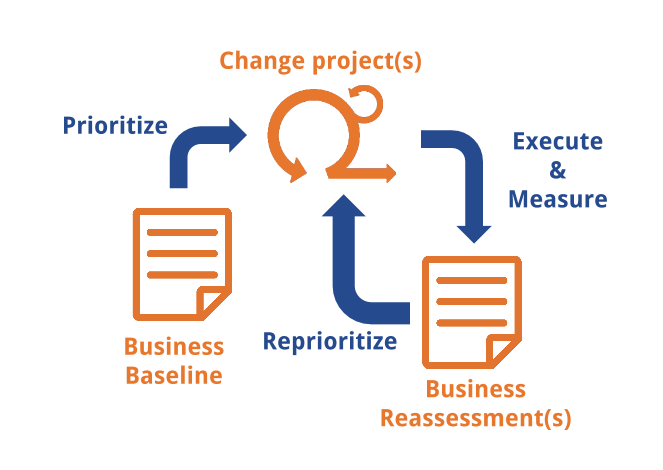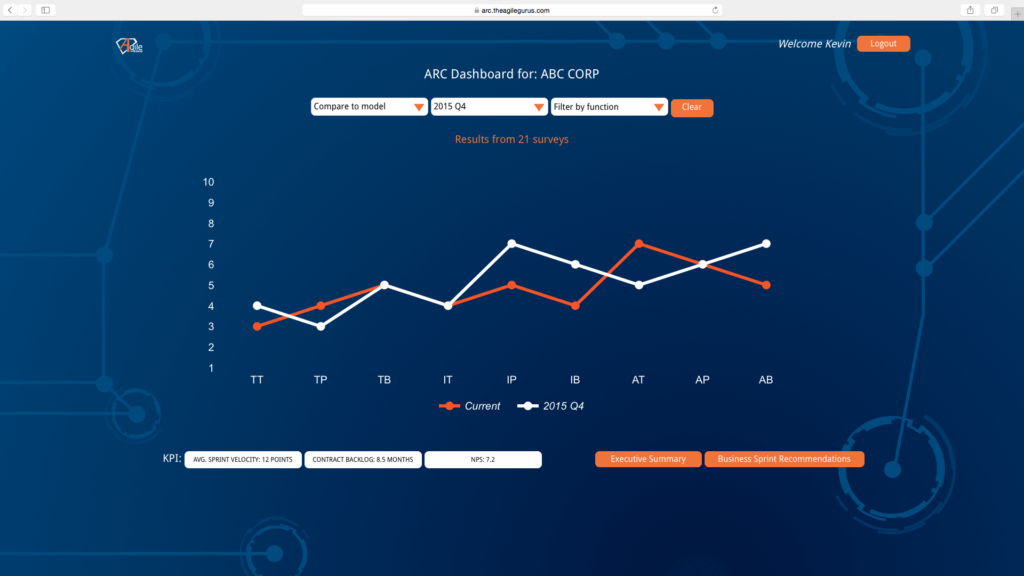by Kevin Miyashiro
Agile businesses are the future because they are often in the best position to exploit the disruptive effects of digital and software technology. A business that follows an agile process can launch the right products faster than its competitors and adapt quickly to changes, both internal and external. A growing body of practitioners called agile coaches specialize in helping businesses, non-profits, and governments, adopt agile processes and agile project management. Agile teams typically report the ability to reduce project delivery schedules by as much as 40 percent. The agile model focuses on teamwork and collaboration, so it is a natural fit for team culture initiatives.
When agile teams are working well, team happiness usually follows. (Or maybe it’s the reciprocal – agile teams are happy, so they work well :P)
Agile project management was something that developed out of the software development industry but has since found its way across departments and whole organizations as a solution to make them more successful and responsive to change.
However, a common struggle for agile coaches is an inability to get their teams to succeed because other functional units in an organization aren’t conducive to agile workflows. This struggle happens because the rest of the organization is perfectly designed to resist agile because it is accustomed to operating within its traditional processes and behaviors. Transforming the organization into a more agile one is an apparent answer, but the not-so-obvious part is: How?
Only when you can present a good case to the client’s executive team for “Why you should transform your business to be more agile” in the same breath, “I can show you how to transform your business to be more agile” will you get a leg-up over other coaches that only focus on project-level agile coaching.
The problem typically isn’t a lack of awareness of your need for agility, but rather, it is a lack of understanding of how to best transform your organization’s environment into one more conducive to agile.
This piece offers concrete ways to take smaller steps to let various parts of companies slowly take steps toward a more agile and thus successful future.
[Author’s Note: Throughout the rest of this article, I’ll use the terms agile and agility interchangeably.]
No agile? No measuring to improve.
At The Agile Gurus, we’ve found that when an organization lacks a common framework and language for guiding an agile transformation:
- The business struggles to communicate.
- The business struggles to set priorities.
- The business struggles to identify progress.
The inability to communicate clearly, prioritize, and assess progress inevitably results in a failure of the organization to transform which means the agile project management teams often end up disbanding because it’s too hard to exist within the legacy structure. The agile coach is let go, and everything goes back to the way it was. And that’s just not cool.
There’s got to be a better way!
Okay, we’ve established that we’ve got a problem. Now let’s talk about what can be done about it.
Agile Process Step 1: Introduce a common framework and language.
For many software projects, agile is widespread and well practiced. But what about human resources? Purchasing? Customer service? These functional units inevitably interact with agile project teams, and this is where the friction usually arises, as most business operations functions are not commonly associated with agile.
With agile’s roots strongly tied to IT, the common perception is “Agile is not for business operations” so there is very little motivation to learn how and why agile can actually transform an entire business, not just product development. So Step One is to get everyone on the same sheet of music. And one of the best ways to do that is to introduce a common framework and language that everyone can use to communicate.
Agile Process Step 2: Prioritize and execute change projects.
Once people are aligned with a common framework and language, we can start the heavy lifting of doing the agile transformation. But time, money, and manpower are all finite resources, so we can’t take on everything. This means we need to prioritize our activities. Wouldn’t it be so awesome if we could recognize patterns in what elements of a business are its greatest impediments to Agile?
Once we know which elements are the greatest barriers to success, we can make well-informed prioritization decisions for which change projects to tackle first. These change projects would be focused on changing the necessary tools, processes, and behaviors that are the blockers to achieving the organization’s agility goals.
Agile Process Step #3: Measure performance, reassess, lather, rinse, repeat.

The final key ingredient is the ability to measure performance of our change projects. Just like any project, a change project needs to answer certain basic questions, such as “Are we on schedule?” and “Are we on budget?”
For a business agility transformation project a unique question is: “Is the organization changing for the better?” In order to do this, a measurement tool such as an assessment tool is necessary. A well-crafted assessment tool will pull data from a variety of objective and subjective sources while ensuring the collection and analysis process minimizes biases along the way. With the assessment tool, the executive team can monitor progress in order to determine the return on investment of the agile transformation initiatives.
Armed with a framework and a language, prioritization process, and an assessment tool, any business agility transformation has a much greater chance of success compared to an ad hoc “Let’s just try a small pilot project and see what happens.”
The Agility Readiness Canvas
Next, we’ll describe our Agility Readiness Canvas (ARC) which is a business agility transformation system we developed at The Agile Gurus to help organizations succeed with their agile transformations.
Why can agile coaches can benefit from systems such as ARC? There’s a good chance your client’s executive team is already aware of the benefits of agile project management, which is why they hired you. They’re probably be aware that this thing called “agility” is good for business. But odds are low they won’t make the connection between transforming functional areas outside of product development. It’s even more unlikely that they won’t know how.
By understanding the ARC system and process, you will be in a great position to inform and influence their decision process to transforming the business’ other functional areas, thereby making your success as an agile coach much more likely!
In order to better communicate with teams across whole organizations, each Agile Readiness Canvas includes:
- common language (no industry jargon!)
- a set of processes that guide execution
- tools to measure results and reprioritize

The Agility Readiness Canvas framework
The ARC system starts by assessing the business as it exists today to form a Business Baseline.
Based on the findings of this baseline assessment, a list of prioritized change projects are created. These change projects are also known as Business Sprints. As the Business Sprints are executed, the outcomes of each Business Sprint are measured.
On a regular basis, a Business Reassessment is performed to assess how the Business Sprints have impacted the overall business.
The core components of the ARC system are:
- Assessment process
- ARC dashboard
- Business Sprint Process
How does an ARC assessment work?
The Agility Readiness Canvas measures the
- Tools used to operate the business
- Processes used to execute activities
- Behaviors that indicate the culture of the business
And maps how these three elements affect the business’ ability to be:
- Transparent with data, which is a measure of how well the business can collect the data most relevant to its success
- Inspect the data, which is a measure of how well the Business can analyze, understand, and make decisions based on the data
- Adapt, which is a measure of how well the Business can change course when the inspection of data indicates it is desirable or necessary to do so
The nine parts of the Agility Readiness Canvas for assessment framework
- Transparency Tools (TT)
- Transparency Processes (TP)
- Transparency Behaviors (TB)
- Inspection Tools (IT)
- Inspection Processes (IP)
- Inspection Behaviors (IB)
- Adaptation Tools (AT)
- Adaptation Processes (AP)
- Adaptation Behaviors (AB)
This nine-part assessment collects information from a variety of sources to give a full 360-degree view of the business, including:
- Executive team inputs
- Financial and contract information
- Surveys from employees, customers, and vendors
- One-to-one interviews with employees
- Environmental observations
The Agility Readiness Canvas dashboard

Once the current state of agile assessment is complete, the results are displayed on the ARC dashboard, a web-based tool that contains all of the information related to the ARC assessment. The visual representation, combined with additional subjective information, makes the process of prioritization much more effective.
Each of the nine ARC elements receives a ranking from 1 to 10 with 10 being the highest. Comparisons between the current ARC assessment and prior assessments are possible to make it easy to see progress over time.
What is a Business Sprint?

A Business Sprint is a focused, short-term project that is designed to induce incremental change in a team’s tools, processes, or behaviors. We illustrate the process flow of a Business Sprint below:
We have an entire library of tools, techniques, and tips for the various ways to run a Business Sprint.
Why do we need so many options? Unlike a project sprint for a software project, the possibilities for a Business Sprint scope is nearly unlimited because Business Sprints are tasked with changing whatever tools, processes, and behaviors that stand between the Business of today and the Agile Business of tomorrow. Here’s a small sampling of Business Sprints:
- Experiment with open floor plans for a product development team
- Upgrade the sales team from Excel spreadsheets to a cloud-based customer relationship management (CRM) tool
- Create a process for collecting and analyzing customer sentiment
- Coach team members for how to have productive “crucial conversations.”
- Experiment with rapid prototyping tools for launching product demo’s
Notice anything about the general characteristics of Business Sprints?
First off, none of them are going to single-handedly “change the world.” In fact, they seem, well, underwhelming. That’s actually one of the key points to a Business Sprint. The smaller the change induced, the less likely people will resist the change. This means that the Business Sprint has a greater probability of successfully adding positive change to the business. The important thing to remember is there is a strategy for prioritizing Business Sprints and a huge component of the strategy is understanding when and how to sequence Business Sprints so that the cumulative effect becomes “world changing.”
The second thing to notice is how focused a Business Sprint is. Business Sprints focus on accomplishing one thing in a short duration, usually lasting three to six weeks. The focus further increases the odds of success for the Business Sprint because the the people executing the activities aren’t multi-tasking.
Is Business Agility critical for your organization?
Business Agility isn’t a nice-to-have anymore–today it’s mission critical and most execs already know it. But there aren’t a lot of systems out there that make it easy to know how to transform a traditional business into a more agile one, which is why we created the Agility Readiness Canvas.
So for all of the Agile Coaches out there, if you’re finding your client’s business environment is getting in the way of your agile team’s success and you need help getting their executive team on board with transforming their Business, please reach out to us and we’ll do our best to give you some ammo for your next conversation!
Now, you tell us below! How have you spread business agility across organizations?

